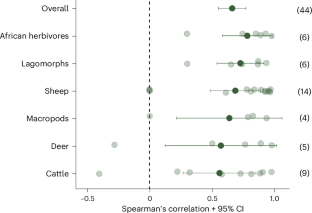Dung predicts the global distribution of herbivore grazing pressure in drylands
IF 23.6
Q1 FOOD SCIENCE & TECHNOLOGY
引用次数: 0
Abstract
Dryland grazing sustains millions of people worldwide but, when poorly managed, threatens food security. Here we combine livestock and wild herbivore dung mass data from surveys at 760 dryland sites worldwide, representing independent measurements of herbivory, to generate high-resolution maps. We show that livestock and wild herbivore grazing is globally disconnected, and identify hotspots of herbivore activity across Africa, the Eurasian grasslands, India, Australia and the United States. Wild herbivore dung mass was negatively correlated with total organic nitrogen, yet strong site-level correlations exist between our livestock dung estimates and total soil organic nitrogen. Using dung mass as a proxy of herbivore abundance enables standardized, field-based measures of grazing pressure that account for different herbivore types. This can improve herbivore density modelling and guide better management practices for populations that rely on dryland-grazing livestock for food. Global maps of dryland livestock and wild herbivore dung mass show that dung can be used as a proxy for herbivory to improve herbivore density modelling and guide dryland management strategies.


Dung预测了旱地食草动物放牧压力的全球分布
旱地放牧维持着全世界数百万人的生计,但如果管理不善,就会威胁粮食安全。在这里,我们结合了来自全球760个旱地调查的牲畜和野生食草动物粪便质量数据,代表了食草动物的独立测量,以生成高分辨率的地图。我们发现家畜和野生草食动物的放牧在全球范围内是脱节的,并确定了非洲、欧亚草原、印度、澳大利亚和美国的草食动物活动热点。野生草食动物粪便质量与土壤总有机氮呈负相关,而畜禽粪便质量与土壤总有机氮呈强相关。使用粪便质量作为草食动物丰度的代表,可以实现标准化的、基于野外的放牧压力测量,以解释不同的草食动物类型。这可以改进草食动物密度模型,并为依赖旱地放牧牲畜的人口提供更好的管理实践指导。
本文章由计算机程序翻译,如有差异,请以英文原文为准。
求助全文
约1分钟内获得全文
求助全文

 求助内容:
求助内容: 应助结果提醒方式:
应助结果提醒方式:


